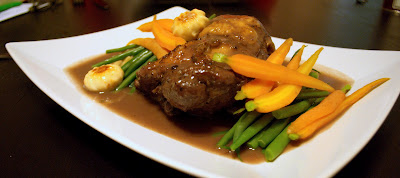Monkfish was being sold at the grocery story. That meant opportunity to try this (as it turns out) slightly sweet, mild, and meaty fish. Not knowing about it, I turned to Thomas Keller for guidance.
The French Laundry Cookbook has a dish pairing the fish with a braised beef cut (oxtails). Wow...fish and a rich braise. This must be some fish, I thought. Sure enough, it really holds its ground and pairs well with the sauce. A lot of earthy flavors in this dish, with the salsify (another new ingredient for me), and porcini mushrooms. All in all, pretty easy to do, and worth the effort since I had a lot of sauce left over and enough fish for a second meal.
I also have been trying to play with sugar decor. I haven't gotten the results that I wanted (not pictured), but I did something simple, which you can see above. This is simply a caramel drizzled onto a silpat in a pattern and then folded over on itself.
I whipped up a simple chocolate cookie wafer and had some pistachio gelato in the freezer, which I framed with the caramel decoration. Fun stuff.














